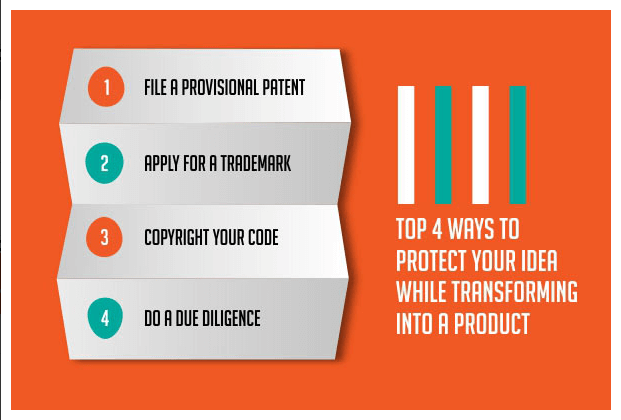
Step 1: Run for filing a provisional Patent Application: Freeze your earliest possible priority:
Provisional Patent application is the simplest way in providing first layer protection to the budding idea, by gaining priority even when the idea is incomplete. Filing the provisional patent application provides a benefit of extra time to fully nurture the idea into a product and it also provide a market benefit by showing a patent pending status.
After filing provisional application, a complete disclosure in the form of complete patent application should be filed with 12 months of filing the provisional application. The complete Application discloses all the essential details of the idea and provides several beneficial rights to a Patentee.
Step 2: Protect your Brand name: Apply for a Trademark
Trademark helps in providing a protection for recognizable symbol, design, or expression associated with an entity providing goods, products and/or services. Trademark registration provides rights in safeguarding one’s name of trade.
According to the Indian Trademark system, under the trademark registration process, one of the biggest advantage is that the entity may suffix the letters ‘TM’ with the brand name, right after the Trademark application has been filed.
Step 3: Copyright Protection: Safeguarding one’s creative work
Copyright registration process is one of the economic way that may help in transforming the creative work into a highly useful asset. Copyright protection provides protection of Literary, dramatic, musical, or artistic work or any other aesthetic creation whatsoever including cinematographic works and television productions.
Copyright could be easily filed by an individual who is an author or owner of the work in multiple modes, including post filing or e-filing from the Government website for filing copyright. Copyright registration serves as a prima facie evidence in claiming a true ownership when the work gets copied.
Frequently seen mark of © represents an ownership on various type of creative work, such as presentation, deigns, drawings and paintings, computer programs and alike. So use of this mark helps in claiming originality over the creative work.
Step 4: Due diligence: Prior investigation
Due diligence generally refers to a voluntary investigation and verification to avoid in committing a tort or offence. Due diligence plays a vital role before initiating any IP related process especially for small organizations or start-ups. This will help in adopting correct practices and minimizing risk and loss.
One of the basic step in performing due diligence is, recording everything in documents in each cycle of transformation of idea into the product. Such recording will include details of all works related to idea transformation, any reference used while working on the idea, additional notes and remarks, resources employed and alike.
The above listed four steps will help in creating a strong IP portfolio thereby increasing strength of an organization by providing a support of shining IP asset stars.



